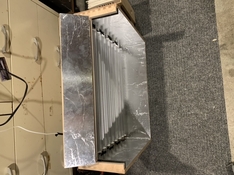@MTGseattle there's quite a bit of experimentation going on in the pigment printing arena, with people trying other sensitizers besides dichromate and DAS, and also plant proteins instead of gelatin or gum.
Keep in mind that the reason why gelatin works in carbon printing is because of the long-strain molecules that get entangled and linked up ('crosslinking') by the use of e.g. dichromate or DAS. Polysaccharides like gum arabic and agar agar behave differently; they sometimes exhibit somewhat similar behavior (at least superficially). See e.g. gum printing, where gum arabic is hardened with gelatin. However, the chemistry is different and the mechanics of producing a print, too; e.g. with gum printing there's no 'transfer' as such and I don't think it would actually work if you tried.
Agar agar does play a small role in the Chiba system that uses ferric ammonium citrate as a sensitizer. Here, the agar agar isn't the actual binder for the pigment, but it seals off the gelatin matrix so that oxygen doesn't create problems with the hardening and subsequent adhesion of the gelatin to a substrate. I've read recent reports from one printer who does away with the agar agar and simply uses gelatin and FAC. I've tested this too about a year ago but the results were problematic; no transfer seemed to be possible. However, in these cases gelatin is still used as the pigment binding medium.
The alternative plant proteins are so far mostly/only used in direct printing process, so processes without a transfer, like gum bichromate. I've seen reports of lupin proteins in particular being successfully used in a brush-on method, using FAC as a sensitizer. While such prints are also pigment prints and they also employ proteins, the printing mechanics are quite different from carbon transfer as we know it, and the results are, too.
The short answer is that so far I've not seen a drop-in replacement for animal gelatin in actual carbon transfer printing. If you broaden the scope to pigment processes, then there certainly are other options out there.
I also stumbled across Porcine gelatin as well.
For my first foray, I'll likely use a bovine version to minimize variables.
I use both bovine and porcine gelatins and apart from the smell, I notice no particular difference in the sense that one is more difficult to print with than the other. It really doesn't matter.


 I've been using it for years, and quite happy.
I've been using it for years, and quite happy.


